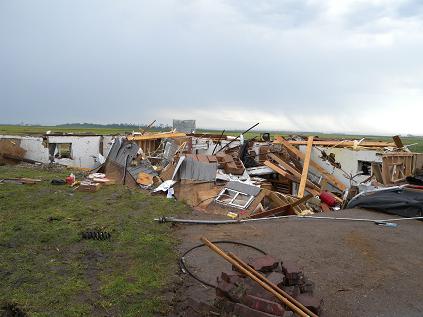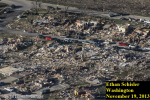7. Rochelle-Fairdale 2015 - Y'all beat me to this one, so don't need to share most of my pics. Here's a quote I saved from @buckeye05 from page 6 in this thread.
"As this tornado struck the Deer Creek subdivision to the north of town, numerous EF5 hallmarks occurred. Multiple large, modern, well-anchored homes were swept away, with the debris granulated and wind-rowed long distances. Mowed, short lawn grass was scoured from the yards of several of these homes as well. Most impressively, a concrete sidewalk leading to the front door of one of these homes was actually shifted and pulled away from the driveway and house (photo below). The low-level winds that would have been needed to move this sidewalk would have to have been absolutely insane."

8. Chapman 2016 - The most impressive contextuals I've ever seen, it really encapsulates what Ted Fujita said about F5 tornadoes "leaving behind a path of destruction so severe that it could defy explanation due to the sheer force of the winds involved". It could easily be anywhere on people's top 10s (even #1) and I wouldn't argue. It literally fused a truck with a combine, moved railroad tracks (it was only 85 degrees that day so I don't want to hear anyone mention thermal expansion), snapped the foundation of a well built brick farm house, and mangled cars in ways that defy explanation.








"As this tornado struck the Deer Creek subdivision to the north of town, numerous EF5 hallmarks occurred. Multiple large, modern, well-anchored homes were swept away, with the debris granulated and wind-rowed long distances. Mowed, short lawn grass was scoured from the yards of several of these homes as well. Most impressively, a concrete sidewalk leading to the front door of one of these homes was actually shifted and pulled away from the driveway and house (photo below). The low-level winds that would have been needed to move this sidewalk would have to have been absolutely insane."

8. Chapman 2016 - The most impressive contextuals I've ever seen, it really encapsulates what Ted Fujita said about F5 tornadoes "leaving behind a path of destruction so severe that it could defy explanation due to the sheer force of the winds involved". It could easily be anywhere on people's top 10s (even #1) and I wouldn't argue. It literally fused a truck with a combine, moved railroad tracks (it was only 85 degrees that day so I don't want to hear anyone mention thermal expansion), snapped the foundation of a well built brick farm house, and mangled cars in ways that defy explanation.























